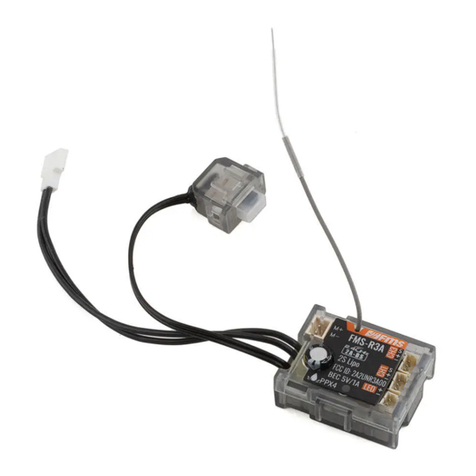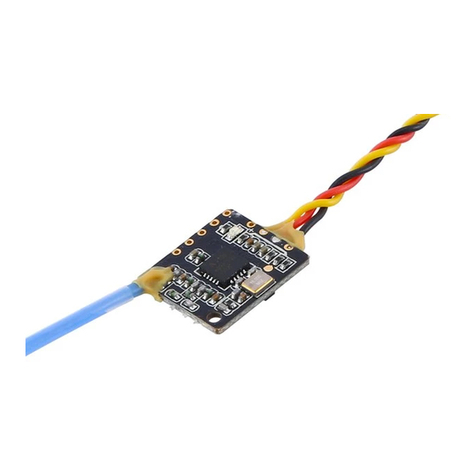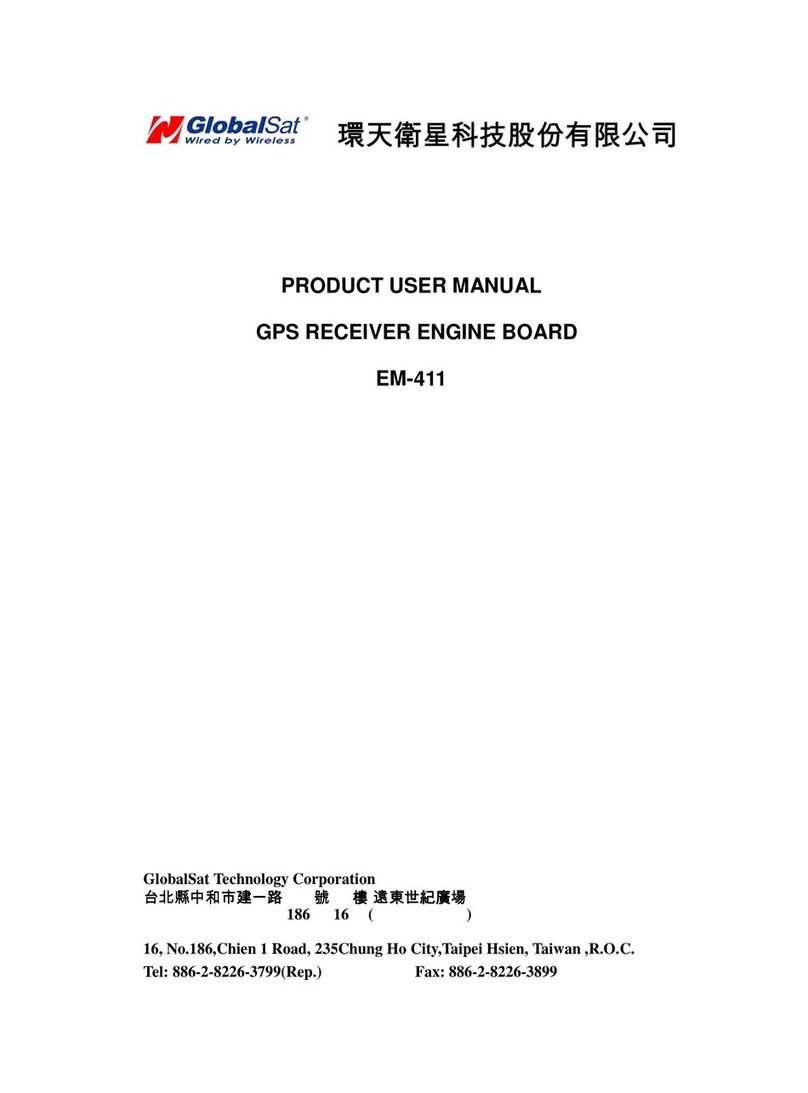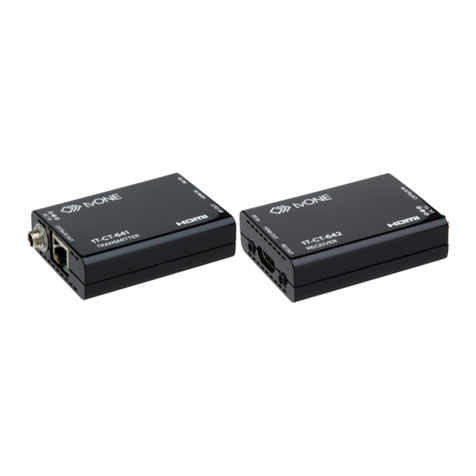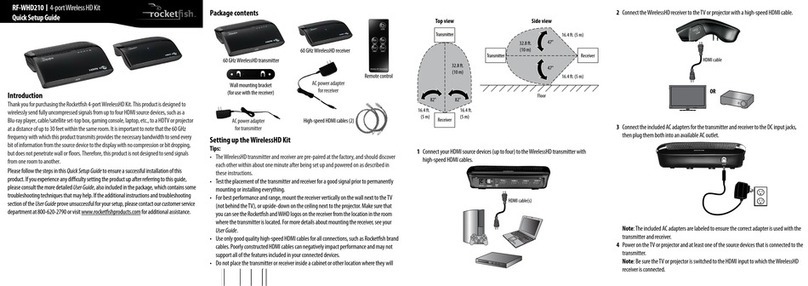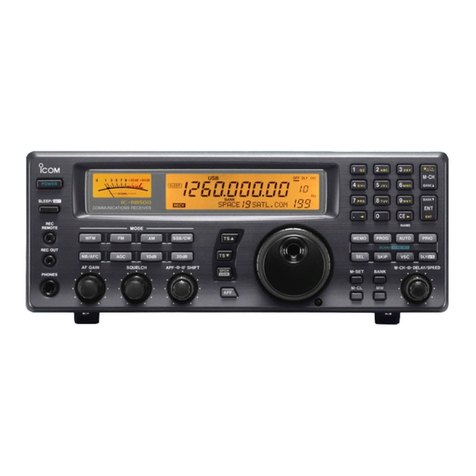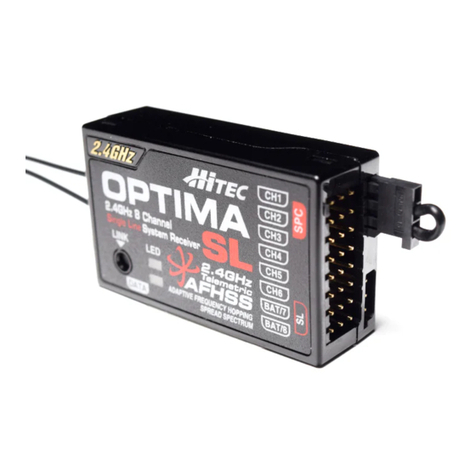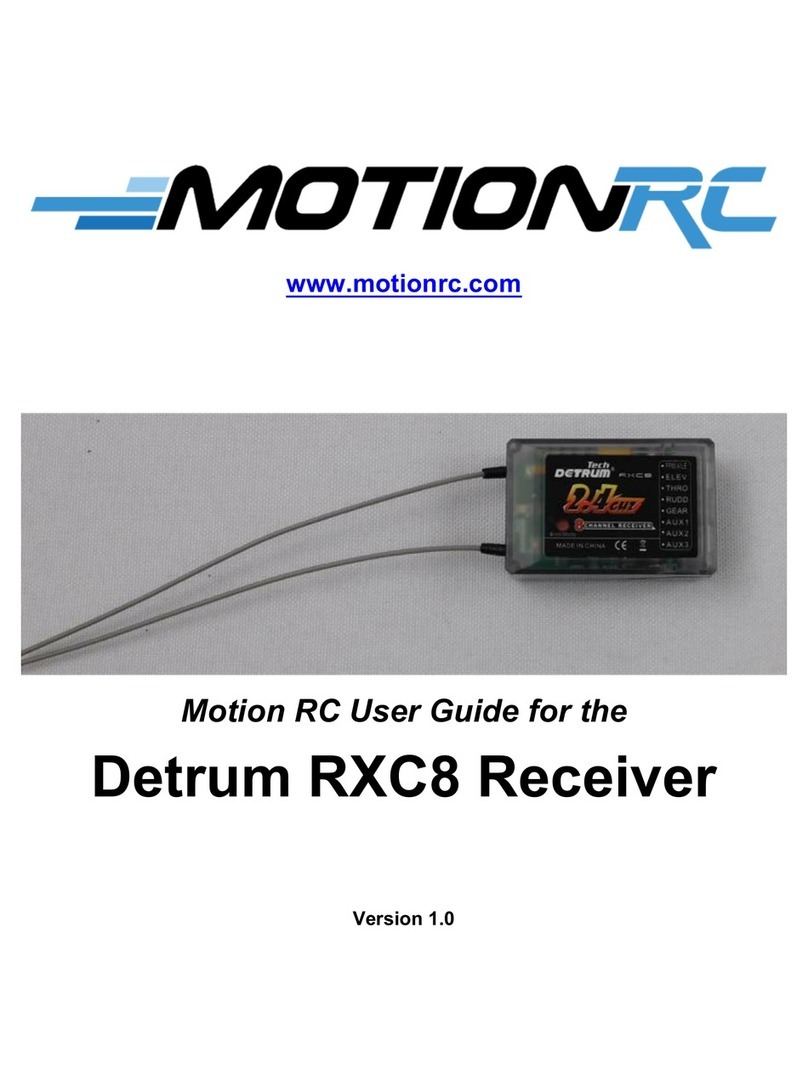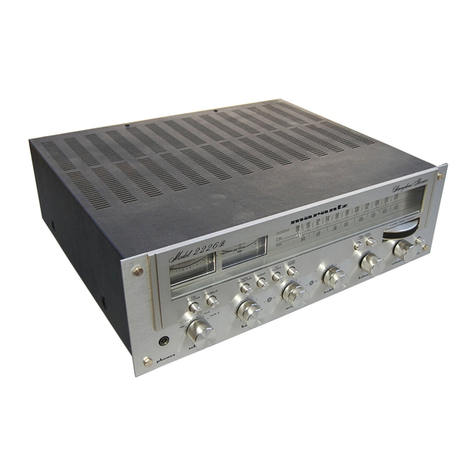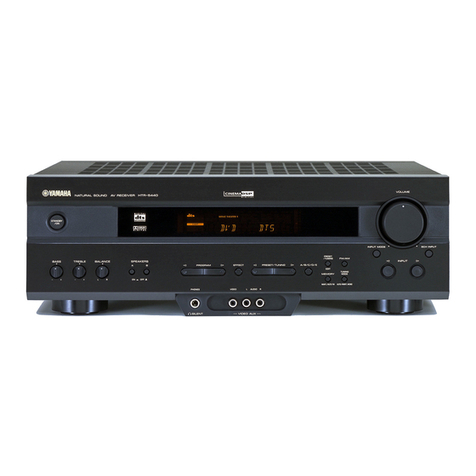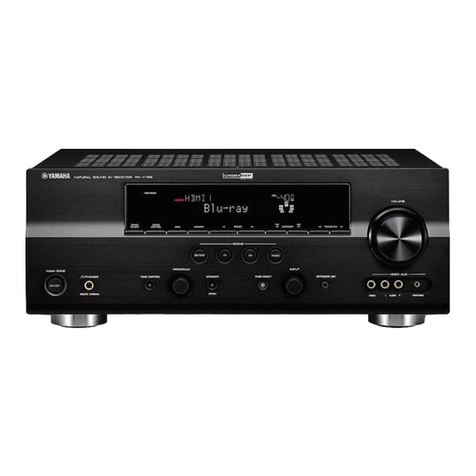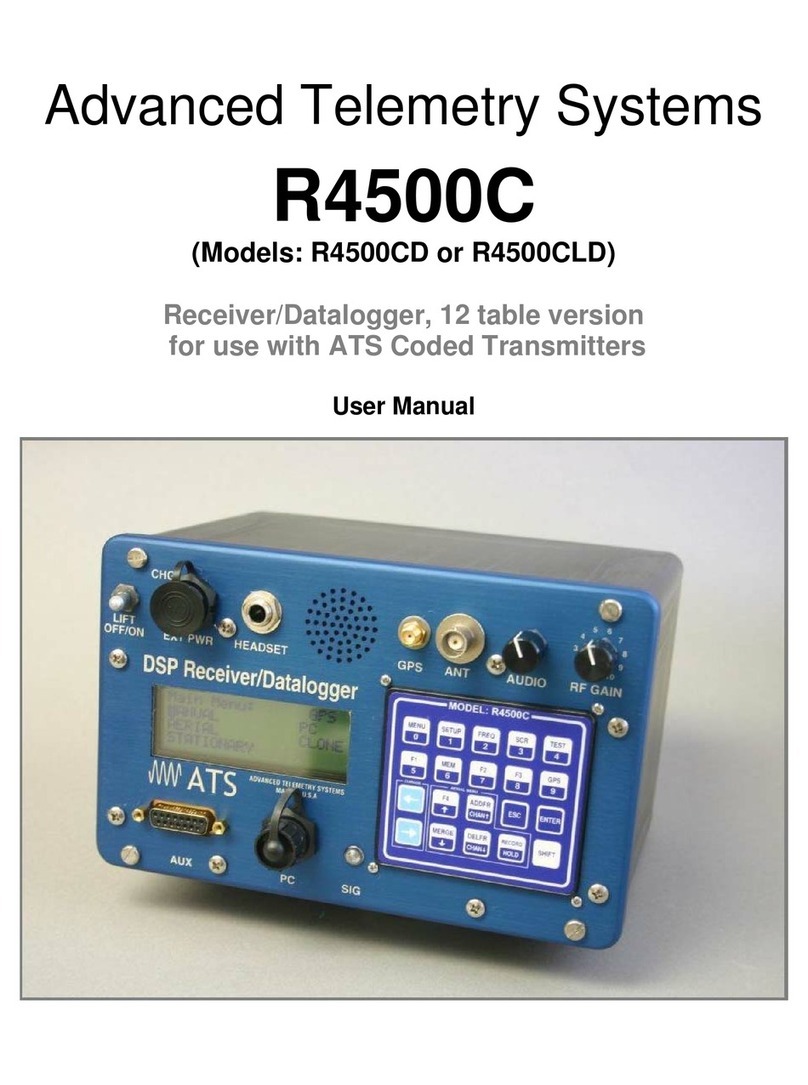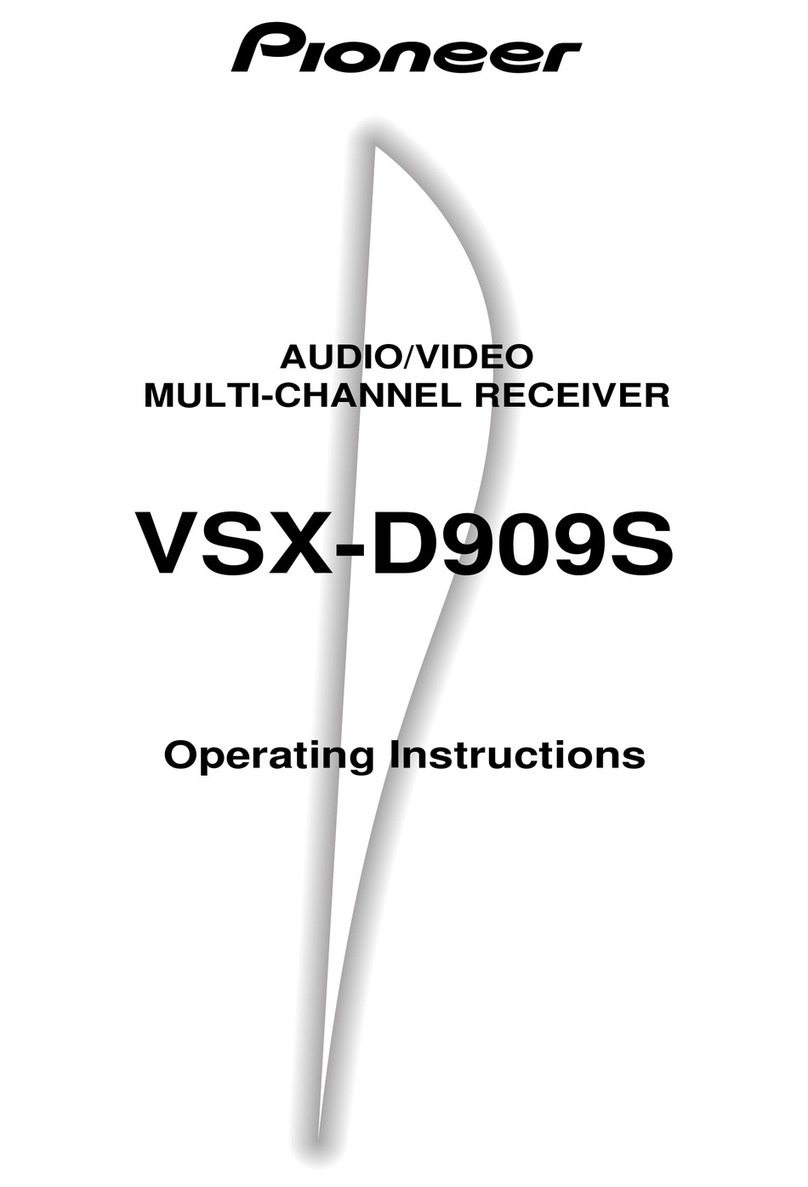Newport 2007 User manual

Model 2007 & 2017 User’s Manual
Nirvana Auto-Balanced
Photoreceivers
Patent No. 5,134,276
These photodetectors are sensitive to electrostatic
discharges and could be permanently damaged if
subjected even to small discharges. Ground your-
self adequately prior to handling these detectors or
making connections. A ground strap provides the
most effective grounding and minimizes the
likelihood of electrostatic damage
phone: (877) 835-9620
e-mail: tech@newport.com • www.newport.com

2
Contents
90099912 Rev. A
I Quick Start 3
II Detector Operation 5
III Principles Of Operation 17
IV Operating With Optical Fiber 20
V Applications Examples 22
VI Troubleshooting 30
VII Warranty, Service and Support 32
VIII Specifications 33

3
This section outlines the quickest path to using the Nirvana
photoreceiver. For more detail on how to operate the Nirvana, see
Section II, Detector Operation. For more information on using the
Nirvana with fiber inputs, see Section IV, Operating With Optical Fiber.
1. Set up your optical experiment with a reference beam impinging on
the REF photodiode and your signal beam impinging on the SIGNAL
photodiode. Use an optical power between 0.1 mW and 1 mW to
facilitate oscilloscope display of your results. Make sure that your
beamsplitter produces more power in the reference beam than in
the signal beam (attenuate the signal beam if necessary).
2. Apply ±15 VDC power to Nirvana. See page 9 for more details on the
power supply connectors.
3. Switch the Linear Output knob to the SIG mode. Turn the Loop
Bandwidth knob to 100. For more detail on this function, see page 14.
4. Attach an oscilloscope to the SIGNAL MONITOR back panel BNC.
Adjust the signal beam coupling, the oscilloscope display control, and
your modulator input settings until the expected voltage waveform
display appears on the oscilloscope. For instance, if your modulator is
an optical chopper running at 1 kHz and 50% duty cycle, your output
oscilloscope trace is expected to be a square wave at 1 kHz, 50% duty
cycle, with an amplitude proportional to the received signal power.
5. Connect the oscilloscope to the back panel LINEAR OUTPUT BNC.
The displayed voltage should again be the expected replica of your
optical modulation. In the case of the chopper input, your displayed
square wave should now show some enhanced edge response.
I
Quick Start

4
6. Block the signal beam with an opaque card. Switch the Linear Output
knob to BAL. Adjust the reference beam coupling to maximize the
LINEAR OUTPUT voltage.
7. Unblock both REF and SIGNAL beams and switch the Linear Output
knob to AutoBAL.
8. If you are measuring a DC or low-frequency signal, monitor it on the
LOG OUTPUT. If your signal is at high frequencies, monitor it on the
LINEAR OUTPUT.

5
The Newport Model 2007 and 2017 Nirvana photoreceivers eliminate
many noise sources that can plague precision measurements. Nirvana’s
wide signal bandwidth and various outputs and settings give you the
flexibility to design inexpensive shot-noise limited experiments with very
little support electronics. Nirvana is designed for use in a dual-beam
setup: one invariant reference path and one signal path which contains
your experiment. Properly applied, Nirvana reduces common mode
noise by over 50 dB at frequencies from DC to 125 kHz. Thus you can
effectively eliminate laser-intensity noise and make shot-noise limited
measurements at low frequencies without using lock-in amplifiers and
optical choppers. Nirvana’s patented circuitry subtracts the reference and
signal photocurrents, canceling noise signals that are common to both
channels. Unlike conventional balanced receivers, Nirvana’s electronic
gain compensation automatically results in balanced detection, even if
the average optical intensities on the two detectors are different and
time-varying. Nirvana’s voltage outputs allow you to measure signal
power with 50 dB less noise than in a single-beam experiment. In most
cases, the noise floor will be determined by shot noise.
Nirvana is easy to use, but we recommend that you read this guide
thoroughly before you try to set up and use the detector. Before using the
photoreceiver in a fiber system, see Section IV, Operating With Optical
Fiber.
Front Panel Controls
The Model 2007 and 2017 photoreceiver inputs consist of two
photodiodes. One is designated the reference photodiode, labeled REF,
while the other is designated the signal photodiode, and labeled SIGNAL.
The outputs of the Nirvana photoreceiver are a set of user-selectable
functions of the optical power applied to these photodiodes. When
planning to use the detector in auto-balanced mode, be sure that the
reference photodiode receives more, and ideally twice as much, optical
power as the signal photodiode.
Note: Since there are no windows on the photodiode, keep the
photodiodes covered when not making measurements for extended
periods of time.
II
Detector
Operation

6
REF SIGNAL
SIGNAL
MONITOR
LINEAR
OUTPUT
LOG OUTPUT
±15 VDC
Model 2007
Nirvana Detector
125 kHz (Vis) Auto-Balanced Photorceiver
Loop
Bandwidth
Linear
Output
SIG BAL
AutoBAL
0 100
10 90
20 80
30 70
40 50 60
10X
Nirvana Back Panel
Nirvana TopPanel
Nirvana Front Panel

7
Top Panel Controls
The function of the Nirvana photoreceiver’s outputs is controlled by a
knob on the top panel. This Linear Output switch controls the operation
of the back panel LINEAR OUTPUT as summarized in the previous table.
With the Linear Output switch set to SIG, the LINEAR OUTPUT BNC
provides a voltage proportional to the signal diode’s photocurrent only.
This function is useful for monitoring the signal power when setting up
the experiment. With the Linear Output switch set to BAL the Nirvana
functions as a traditional balanced detector. The LINEAR OUTPUT BNC
provides a voltage proportional to the difference between the
photocurrents of the signal and reference diodes. Use this mode when
you want a traditional balanced receiver or to verify that the correct ratio
of signal and reference optical powers has been achieved. With the Linear
Output switch set to AutoBAL or 10X, the Nirvana automatically balances
the photocurrents from the signal and reference photodiodes at the
subtraction node. Use these modes for optimum noise cancellation. In
10X mode, the LINEAR OUTPUT BNC’s voltage is ten times greater than
in AutoBAL mode.
Knob Setting Function
SIG Signal monitor, voltage proportional to received SIGNAL optical power.
BAL Traditional balanced detection, voltage proportional to difference
between received SIGNAL and REF optical powers.
AutoBAL Autobalanced detection, zero DC voltage, noise-suppressed AC signal
proportional to received SIGNAL optical power.
10X Autobalanced detection with higher gain. Same as AutoBAL setting,
but with output voltage increased ten times.
Table 1. Back-panel LINEAR OUTPUT BNC function as determined by the top-panel Linear Output
knob position.

8
The Loop Bandwidth knob controls the cutoff frequency of the electronic
gain compensation in auto-balanced operation. In most experiments, the
optimal setting is 100. Nirvana’s auto-balancing is the result of a low-fre-
quency feedback loop that adjusts the gain of the REF photodiode to
exactly balance the SIGNAL and REF photocurrents. In some cases, it may
be advan-tageous to reduce the bandwidth of this feedback by reducing
the Loop Bandwidth knob setting. For more details on this topic see page
14 and Section III, Principles of Operation.
Back Panel Controls
The back panel of the Nirvana photoreceiver contains the power input
con-nector and three voltage output BNC’s. Power for the Nirvana is
enters through the microconnector power input, labeled ±15 VDC.
The SIGNAL MONITOR BNC directly monitors the optical beam on the
signal photodiode. This voltage output has a transimpedance gain of 10
V/mA for the signal photocurrent. This output is unaffected by the top
panel controls or the REF photodiode optical input so it can be used to
monitor the signal power. The output of the LOG OUTPUT BNC
depends on the top panel Linear Output knob setting. When it is turned
to either AutoBAL or 10X, the LOG OUTPUT voltage is:
,
otherwise the output voltage is undefined. This output voltage provides a
con-venient measurement of absorption present in the signal path. It is
bandwidth limited, with a bandwidth determined by the Top Panel Loop
Bandwidth knob, and the REF and SIGNAL incident optical powers, as
described in Section III, Principles Of Operation.
LINEAR OUTPUT is a voltage related to the REF and SIGNAL received
optical powers as determined by the top panel Linear Output knob.
LOG OUTPUT P
P
REF
SIGNAL
~ -1n −
1.

9
Making A Measurement
Mounting
Nirvana comes with a customer specified English or metric mounting
pad. Insert the mounting pad into the bottom of the detector housing
and secure with the three 4-40 screws provided. The mounting pad has a
tapped 8-32 or M4 thread for convenient mounting to a pedestal or base.
Power Requirements and Cables
Two different power cables are shipped with the photoreceiver: Model
0923 Pico (m8) double-ended, male power cable for use with the
Newport power supply, and a Model 0924 Pico (m8) male to banana plug
power cable for use with other power supplies. If you have a Newport
Model 0901 power supply, use the Model 0923 Pico (m8) double-ended,
male power cable to connect the photoreceiver to one of the power
supply’s 0.3-A microconnector outputs. Use the Model 0924 Pico (m8)
male to banana plug power cable when working with a power supply
other than the Newport Model 0901. Power supply requirements are a
minimum of 0.1 A of current on ±15V. The color convention for the
three banana plugs is:
Banana Plug Voltage Current
Red + 15 V 0.1A
Green COM/GND N/A
Black -15 V 0.1 A
Applying Optical Signals
After mounting the photoreceiver and applying power, direct the signal
and reference beams onto the respective photodetectors. You can check
the cou-pling efficiency of each signal by turning the Linear Output knob
to BAL and monitoring the LINEAR OUTPUT BNC. Successively
blocking each output

10
with a white card will allow you to optimize the coupling into each
photodetector. When you have optimized the alignment, select your
desired operating mode with the Linear Output knob.
Obtaining 50 dB Noise Suppression
To obtain the best possible noise suppression in autobalanced mode, you
must carefully design your optical experiment. This section of the
manual describes proper selection of parameters such as laser power,
power split ratio, and modulation frequency. Further, it describes several
optical component choices which may affect your perceived noise
performance.
The optical setup can greatly affect the observed noise level in your
measurement. Before beginning your experiment, measure the laser
power, the signal modulation frequency (if any) and the power split ratio
(the ratio of reference to signal power after the beamsplitter). Also
measure (or control) the optical polarization of your beams, and losses in
the signal and reference paths.
Laser Power
Figure 1 shows the common-mode rejection ratio (CMRR) vs. frequency
for different photocurrents. The split ratio was fixed at nearly 2:1.
Notice, the common-mode rejection improves with photocurrent. We
recommend received photocurrents in the mA regime, but a low
frequency CMRR of 50 dB can be obtained at microamp current levels.
Improved high-frequency performance at the lower signal levels can
be obtained through adjustment of the split ratio.

11
Modulation
Many experiments can be performed using Nirvana without laser beam
modulation. Simply use the LOG OUTPUT as a measure of signal
absorption directly. In many cases this output can be used in place of a
chopper and lock-in amplifier. For more details on such an experiment
see Section V, Applications Examples.
If your signal is inherently AC (not through signal beam modulation), or
if you wish to take advantage of the narrow-band filtering property of
synchronous detection, you must use the LINEAR OUTPUT. If you are
using a modulated signal, the modulation frequency must be above the
gain compensation cutoff frequency described on page 14 or else noise
cancellation will be degraded.
If the signal beam is inherently modulated (e.g., a spectroscopic line in a
lamp with a pulsed excitation source), noise present in the system is
reduced dramatically in auto-balanced mode. Synchronous detection at f
can serve to further reduce noise by accepting only a narrow bandwidth
near f.
0 1 10 100
-85
-75
-65
-55
-45
-35
-25
-15
Frequency (kHz)
CMRR (dB)
ISIGNAL=2.5 µA, IREF=5 µA
ISIGNAL=25 µA, IREF=50 µA
ISIGNAL=250 µA, IREF=500 µA
Figure 1
Common mode rejection ratio versus frequency.

12
When using modulators for noise-reduction of DC detection
experiments, place the modulator before the signal-reference
beamsplitter. If your signal is inherently DC, you may think to modulate
the signal beam at a frequency fm by placing a modulator in the signal
arm of your experiment. Don’t do this. Because the reference channel
(hence, the noise in the reference channel) is not modulated, the
frequency shifted noise of the signal channel is no longer exactly
replicated in the reference channel, and is therefore not canceled
properly.
Loss in the Optical Paths
Differential, particularly time-varying, losses in the optical paths will be
detected by Nirvana. If these losses are incidental to your experiment,
they may mask your desired observations. Ètalon and polarization
sensitive effects in the two paths are common problems. Ideas on how to
reduce these effects are presented later in this section of the manual.
Split Ratio
The split ratio affects the common-mode rejection achieved with
Nirvana. In general, the power split ratio, PREF /PSIGNAL, should be
close to 2. It is important to remember that it is the received signal power
that is being measured. If the signal or reference arms have significant
optical losses, then these factors must be taken into account when you set
the split ratio. Figure 2 shows the common-mode rejection versus split
ratio at a fixed signal power of 0.5 mW. You can see the common-mode
rejection improve to better than 60 dB as the split ratio approaches 2.2:1.
In general, you must determine the ideal split ratio empirically. Building
your optical setup with the ability to adjust split ratio will ensure optimal
results.
The ideal split ratio is also a weak function of optical power. Figure 3
shows, at a fixed frequency of 5 kHz, the ideal split ratio and
corresponding com-mon-mode rejection versus received signal power.
As you reduce the signal power, the ideal split ratio tends towards 1, and
the best common-mode rejection decreases. However, for received signal
powers of greater than 0.5 mW, the ideal split ratio yields common-mode
rejection exceeding 70 dB.

13
Loop Bandwidth
The Loop Bandwidth knob controls the gain-compensation cutoff
frequency, which determines the speed of the autobalancing effect. You
must set the cut-off frequency as high as possible, but below any
modulation frequency of
1.0 1.5 2.0 2.5 3.0
-60
-65
-50
-40
Split Ratio
CMRR (dB)
8 kHz
64 kHz
-55
-45
-35
-35
-30
-40
-45
-50
-55
-60
-65
-70
-75
-80 0.0 0.1 0.3 0.50.2 0.4
1.1
1.3
1.5
1.7
1.9
2.1
2.3
Signal Power (mW)
Minimum CMRR (dB)
Optimal Split Ratio
Figure 2
Common-mode rejection versus power-splitting ratio.
Figure 3
Minimum CMRR and optimal power-splitting ratio versus
signal power.

14
interest to obtain best noise cancellation and fastest response. The
expression for the gain compensation cutoff frequency is given by:
where PSIGNAL and PREF are the detected optical power in mW, R is
the photodiode responsivity in A/W, and LB is the Loop Bandwidth
knob setting.
This relationship is graphed in Figure 4 with ISIGNAL = PSIGNAL . R.
If you are using a modulated signal, the modulation frequency must be
above the gain compensation cutoff frequency or else noise cancellation
will be degraded. Because the gain compensation cutoff frequency has a
single-pole, RC roll off, the modulation frequency should be
significantly above the cutoff frequency so it does not effect noise
cancellation performance. For example, a 10% modulation one decade
above the cutoff frequency will have a 1% effect on the gain
compensation circuit, thereby reducing noise cancellation performance.
fP
PPR LB
SIGNAL
REF
SIGNAL
c=⋅−
⋅⋅⋅
−
()
6 X 10411
101
0 102030405060708090100
1
10
100
1,000
10,000
Loop Bandwidth
Knob Setting
fc (Hz)
ISIGNAL=500 µA
ISIGNAL=50 µA
ISIGNAL=5 µA
Figure 4
Gain compensation cutoff frequency is determined by Loop
Bandwidth knob setting, signal photocurrent, and the power-split-
ting ratio.

15
Common reasons for lack of noise suppression
The Nirvana detector is a tremendously sensitive instrument for the
measurement of differential optical signals. To the extent that you
understand and control the source of the differential signal, Nirvana will
serve you well. Unfortunately, your measurements will now be sensitive
to effects which previously have been too small to be noticed. Remember,
removing 50 dB of common mode noise will expose effects which were
previously buried in noise. To be certain, we do not know all the effects
which you will discover using Nirvana but we can warn you about a few
which we have observed at Newport.
Laser Polarization
Polarization noise in the source laser can create an unexpected
differential signal due to different polarization sensitive optics in the
signal and reference beam paths. This noise will not be canceled by
Nirvana because it appears as differential amplitude modulation on the
detected light rather than a common mode modulation. For this
problem, it is good practice to begin your optical setup with a polarizer.
Frequency Modulation
Current modulation of diode-laser drive current is notorious for creating
frequency modulation in addition to the desired amplitude modulation.
Many optical elements and coatings act as étalons, converting this
frequency modulation into an amplitude modulation. Because the
reference and signal path optics are different, the unexpected FM results
in a differential signal. A beam-splitter is a likely culprit for étalon effects
and we recommend using either a plate or a Wollaston prism type
beamsplitter, where stray beams are reflected away from the photodiodes.
Spatial Modulation
Modulation techniques and experiments can impart angular deviation
orspatially varying intensities in the laser beam. Non-uniformities in the
photodetectors or vignetting can map this spatial variation into
differential amplitude modulation. Focussing your beams onto the
detectors can help. It is a good idea to use a single lens before splitting
your reference beam from your signal beam if it is possible, and folding
mirrors to focus both beams onto their detector. Liberal usage of
apertures and irises to prevent stray reflections will also be useful.

16
Polarization Wiggle
Several modulation techniques, most notably acousto-optic modulation,
create small rotations in the polarization of the modulated light. If the
optics following the acousto-optic modulator are polarization sensitive,
the polarization rotation becomes an unexpected amplitude modulation.
To remove these problems, follow an acousto-optic modulator with a
polarizer and expect a bit of extra amplitude modulation.
0 20 40 60 80 100
-140
-130
-110
-120
-90
-100
-70
-80
-60
Signal Noise Level, (dB)
Frequency, (kHz)
Auto Balanced Noise
Shot Noise
Laser Noise
Figure 5
Nirvana’s noise cancellation capability (common-mode rejection).

17
This section provides further detail on the operating modes and outputs
of the Nirvana photoreceiver.
Figure 5 shows the type of noise-cancellation performance you can
expect to obtain using Nirvana. We refer to the difference between the
common-mode signal curve and the autobalanced curve as common-
mode rejection ratio (CMRR) which is computed as,
,
where VCOMMON-MODE is the detector output voltage proportional
to PCOMMON-MODE (the laser power present on the reference and
signal photodi-odes at the frequency of interest), VAutoBAL is Nirana’s
output voltage at the same frequency in auto-balanced mode. The
common-mode rejection ratio is a limit on Nirvana’s ability to remove
experimental noise.
The three BNC output connectors on Nirvana’s back panel provide
distinct measurements of the input optical power. The LINEAR
OUTPUT voltage is further determined by the Linear Output switch
CMRR = 20 log V
V
10
COMMON -MODE
AutoBAL
III
Principles
Of
Operation
SIGNAL
MONITOR
LOG
OUTPUT
LINEAR
OUTPUT
SIG Undefined
voltage
20 .R.PSIGNAL at DC,
100 .R.PSIGNAL f>50 Hz
BAL -10 . R . PSIGNAL
Undefined
voltage
20 .R.[PSIGNAL-PREF] at DC,
100 .R. [PSIGNAL-PREF] f>50 Hz
Auto-
BAL -10 . R . PSIGNAL
20 .R.[PSIGNAL – g .PREF] =0 at DC,
100 .R. [PSIGNAL(f) – g.PREF [f)]f>fc
10X -10 . R . PSIGNAL
20 .R.[PSIGNAL- g .PREF] =0 at DC,
1000 .R. [PSIGNAL(f) – g.PREF (f)]f>fc
−−
T
273 g
f
111n,
DC to c
−−
T
273 g
f
111n,
DC to c
Generated Voltage on Nirvana’s 3 BNC Connectors
Linear Output
Mode Switch Setting
Table 2. Mathematical formulas for Nirvana’s voltage outputs.
-10 . R . PSIGNAL

18
setting, as described in general terms in Table 1. Table 2 provides the
mathematical expressions for each of the outputs.
In Table 2, PSIGNAL and PREF are the received optical powers in mW, R
is the photodiode responsivity in A/W, T is the absolute temperature of
Nirvana circuit in degrees K, g is the internally adjusted reference channel
gain PSIGNAL /PREF, f is the frequency of interest and fc is the cutoff
frequency of the automatic gain compensation circuit.
A simplified schematic of the Nirvana is shown on page 36. Nirvana’s
electronics uses a single transimpedance amplifier to generate a voltage
related to the input optical power on the two detectors (the relationship
depends on the switch settings). The voltage is integrated in a low-
frequency feedback loop as an error signal for the autobalance circuitry.
The voltage output amplifier uses both DC and AC paths to provide
higher gain to AC signals while main-taining the ability to monitor DC
levels.
What is the significance of the Loop Bandwidth?
The internal gain g is automatically adjusted by Nirvana’s circuitry to
bring the low frequency portion of the linear output to zero. The cutoff
frequency of the gain compensation circuit is determined by several
parameters: the top panel Loop Bandwidth knob setting, the received
signal power, and the reference power. Keep in mind that common mode
noise is canceled all the way up to Nirvana’s 125 kHz bandwidth limit.
The gain-compensation cutoff frequency is more aptly thought of as the
inverse of the time required for the gain compensation circuitry to adjust
to changes in REF or SIGNAL power.
The gain-compensation cutoff frequency relationship to Loop Bandwidth
knob setting and photocurrent is shown in Figure 6. Figure 6 was
generated with an assumed power split ratio of PREF / PSIGNAL=2. The
cutoff frequency axis scales with received signal photocurrent according
to:

19
Thus, the cutoff frequency can increase to twice the value shown in
Figure 6 for the case of reference power much greater than signal power.
Remember that in your experiments modulation frequencies should be
maintained above the cutoff frequency, and that DC time-resolved
measurements using the LOG OUTPUT are limited to frequencies below
the cutoff frequency.
The LOG OUTPUT is bandwidth limited up to the selected gain-
compensation cutoff frequency. Common mode noise within this
bandwidth is canceled in the LOG OUTPUT. The gain-compensation
cutoff frequency ultimately determines the maximum rate of change of
the LOG OUTPUT, and thus forms a limitation on the temporal
resolution of the measurement of a dynamic system.
fc P
P
∝⋅ −
21 SIGNAL
REF
.
0 102030405060708090100
1
10
100
1,000
10,000
Loop Bandwidth
Knob Setting
fc (Hz)
ISIGNAL=500 µA
ISIGNAL=50 µA
ISIGNAL=5 µA
Figure 6
Gain compensation cutoff frequency, fc, versus Loop Bandwidth
knob setting.

20
The gain compensation circuit requires balancing of the average values of
the signal and reference photocurrents at the subtraction node. In the
event of modulation frequencies (signal modulation) chosen below the
gain-compensation cutoff frequency, the modulation will result in
adjustment of the value of g, with the net effect of creating imbalance
between the reference and signal at the modulation frequency. Noise
cancellation will be adversely affected.
This manual suits for next models
1
Table of contents
Other Newport Receiver manuals

Newport
Newport 2151 User manual

Newport
Newport 1580-A User manual

Newport
Newport 1807 User manual
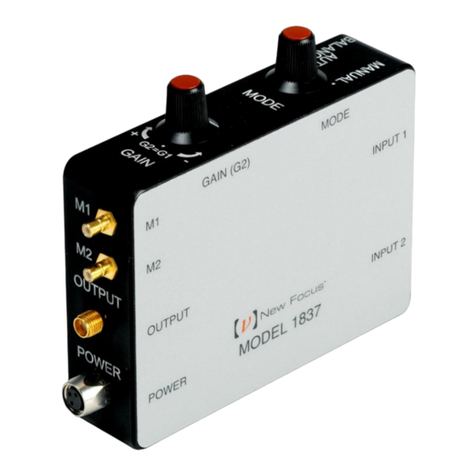
Newport
Newport NIRVANA User manual
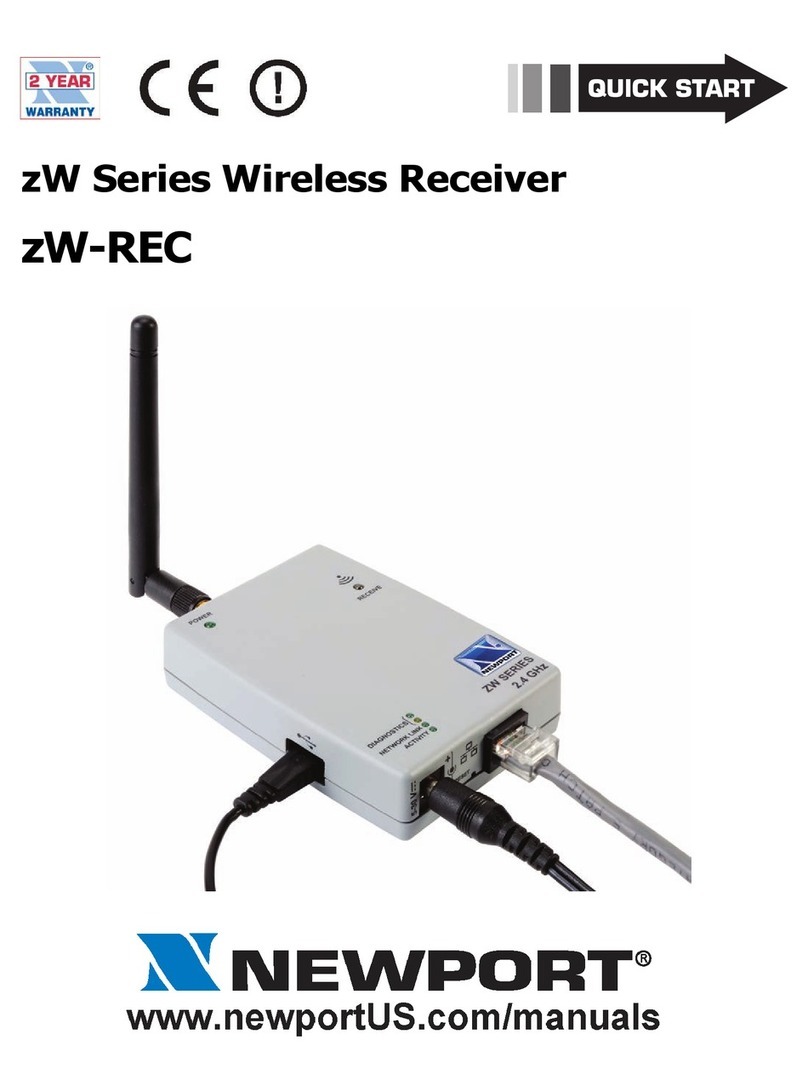
Newport
Newport zW Series User manual

Newport
Newport 1801 User manual
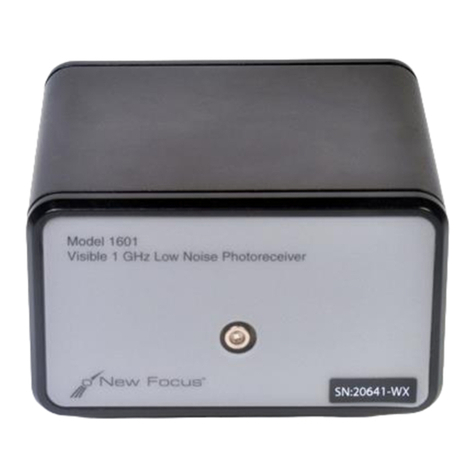
Newport
Newport 1601 User manual
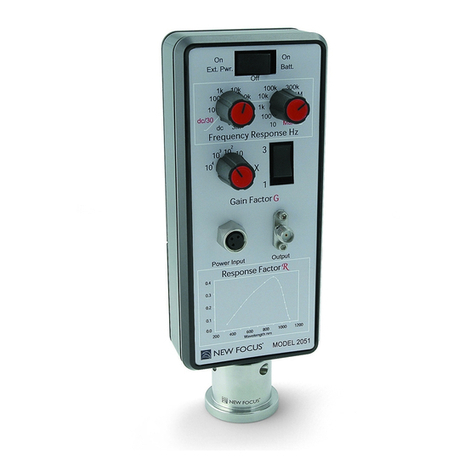
Newport
Newport 2051 User manual
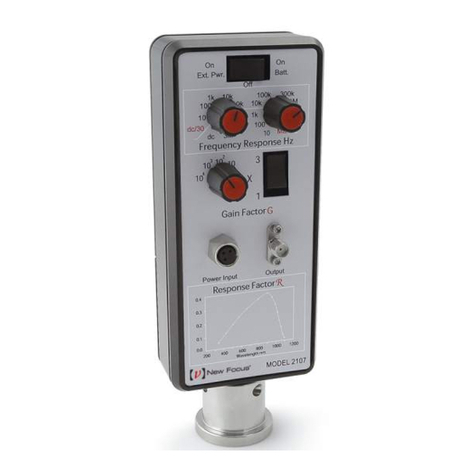
Newport
Newport 2107 User manual
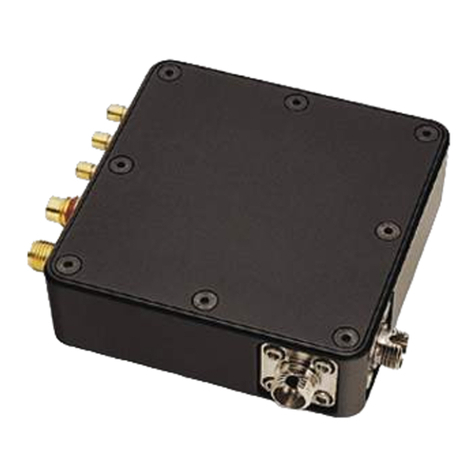
Newport
Newport 1607-AC User manual
